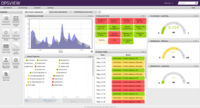Opsview
 Opsview V4's new dashboard | |
| Developer(s) |
Opsview Limited |
|---|---|
| Initial release | 2003 |
| Stable release | Opsview Enterprise 4.4 / July 30, 2013 |
| Preview release | Opsview Core 20130212 / February 14, 2013 |
| Written in | Perl, C, ExtJS |
| Operating system | Linux, Solaris |
| Type | Network and application monitoring |
| License | GNU General Public License and Commercial License |
| Website | www.opsview.com |
Opsview is a software company specializing in enterprise systems monitoring software for physical, virtual, and cloud-based IT infrastructures.[1] Its headquarters is in Reading, England, with a US office in Woburn, Massachusetts. The product aims to provide a single, unified view of IT operations. The company claims that more than 30,000[2] businesses and service providers use Opsview to manage their network devices, physical and virtual servers, storage and cloud systems.
Opsview sponsors a free, open-source software version - Opsview Core. It sells Opsview Pro to SMBs and Opsview Enterprise to larger organisations under a proprietary license.[1]
Technology
Opsview is built with the following technologies:
- Nagios Core: Provides the core set of monitoring and alerting capabilities in Opsview. Sometimes referred to as Opsview's monitoring engine.
- Perl: The primary programming language used for Opsview
- Catalyst: A MVC Web application framework used for building the web application
- ExtJS: a JavaScript library used for building the dashboard in Opsview Pro and Opsview Enterprise
- MySQL: A relational database used for configuration, runtime and data warehouse databases
- Net-SNMP: Provides SNMP support
- RRDtool: Provides lightweight graphing
Opsview runs on Linux with official support for the following distributions: CentOS, Debian, Red Hat Enterprise Linux, SUSE and Ubuntu. It also runs on Solaris 10.[3]
Project history
- 2003 - Project started by James Peel as collection of extensions to Nagios Core
- 2004 - Opsview 1.0 released
- 2005 - Opsview 1.5 released, Ton Voon joins team as development lead
- 2006 - Opsview 2.0 released incorporating Catalyst web framework and Opsview middleware
- 2007 - Opsview made freely available for download, community established. Development continues on Opsview 2.x
- 2008 - Opsview voted Best System Management Tool at LinuxWorld Expo in San Francisco. Opsview acquired by Opsera Limited.
- 2009 - Opsview 3.0 released. Community and Enterprise editions launched. Opsview Community 3.5 released
- 2010 - Opsview Enterprise 3.6 released (May); Opsview Community 3.7 released (June); Opsview Enterprise 3.8 released (July); Opsview Community 3.9 (September); Opsview Enterprise 3.10 (November)
- 2011 - Opsview Community 3.11 released (January), Opsview Enterprise 3.12 (April), Opsview Community 3.13 (July), Opsview Mobile (August), Opsview Enterprise 3.14 (October)
- 2012 - Opsview Enterprise 4.0 (April). Opsview Pro announced (April), Opsview Core announced + Opsview On-Demand (May)
- 2012 - Opsview Enterprise and Opsview Pro 4.1 released (July)
- 2012 - Opsview Mobile for iOS released (August)
- 2012 - Opsview Enterprise and Opsview Pro 4.2 released (November) includes 'Ultra-fast Autodiscovery'
- 2013 - Opsview Core 20130212 released including overhaul of core engine (leveraging Nagios 4 Core code) and a completely rewritten database component (NDOUtils) to offer significant performance gains (February)
- 2013 - Opsview Enterprise and Opsview Pro 4.3 released featuring VMware ESX/vSphere autodiscovery; agentless Windows auto discovery; out-of-the-box monitors for enterprise stacks like Windows Server 2013, Oracle RDBMS, Netapp ONTAP Storage, VMware vSphere, Apache HTTP Server, MySQL, MS SQL; Multi-master dashboard views; and Nagios 4 integration (April)
- 2013 - Opsview Enterprise and Opsview Pro 4.4 released including NetFlow analytics for Opsview Enterprise, Service Desk integration with OTRS and Salesforce Service Cloud, out-of-the-box support for Amazon CloudWatch and improved multi-tenancy (July)
Awards
- Opsview Enterprise 3.10 won the 2011 Techworld One to Watch award at their annual awards ceremony[6]
Reviews
- Opsview Community Edition review at Techworld.com[7]
Conferences
- Opsview 3 was presented in a Lightning Talk at FOSDEM 2009[8]
- Ton Voon spoke about Opsview at the The Open Source Monitoring Conference on Nagios in October 2009[9]
External links
- Official Opsview Website
- Techworld Monitoring the pulse of IT Blog
- ohloh
- Metaways Open Source Monitoring (German Opsview Service Partner)
References
- ↑ 1.0 1.1 "Opsview Updates Opsview Enterprise, Launches Pro Version". MSPMentor. Retrieved 2009-04-24.
- ↑ http://www.opsview.com/about-us
- ↑ "Supported Platforms and Software (Opsview 3.1)". Opsview Project Team. Retrieved 2009-07-28.
- ↑ "LinuxWorld 2008 Product Excellence Awards". Linux Magazine. Retrieved 2008-08-06.
- ↑ "LinuxWorld 2008: LinuxWorld.com and IDG World Expo Announce Product Excellence Award Winners at LinuxWorld and Next Generation Data Center Conference & Expo". Techshow Wire. Retrieved 2008-08-05.
- ↑ "Techworld Awards winners announced". Techworld. Retrieved 2011-06-30.
- ↑ "Opsview Community Edition (Techworld.com)". Techworld.com. Retrieved 2010-09-02.
- ↑ "Opsview: Network monitoring made easy". FOSDEM. Retrieved 2009-02-07.
- ↑ "Open Source Monitoring Conference on Nagios". Netways. Retrieved 2009-08-21.